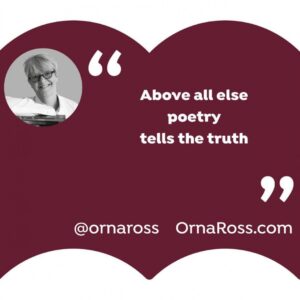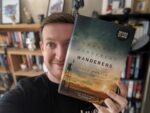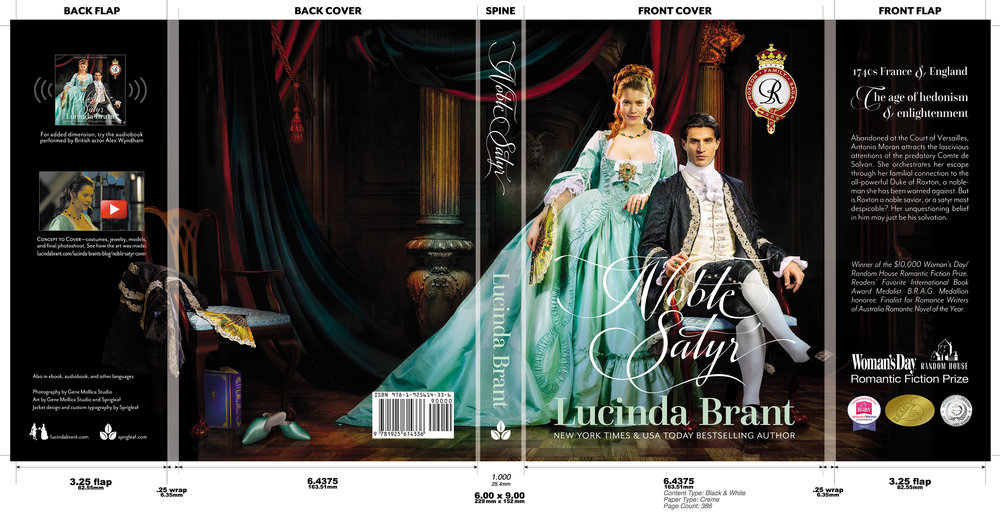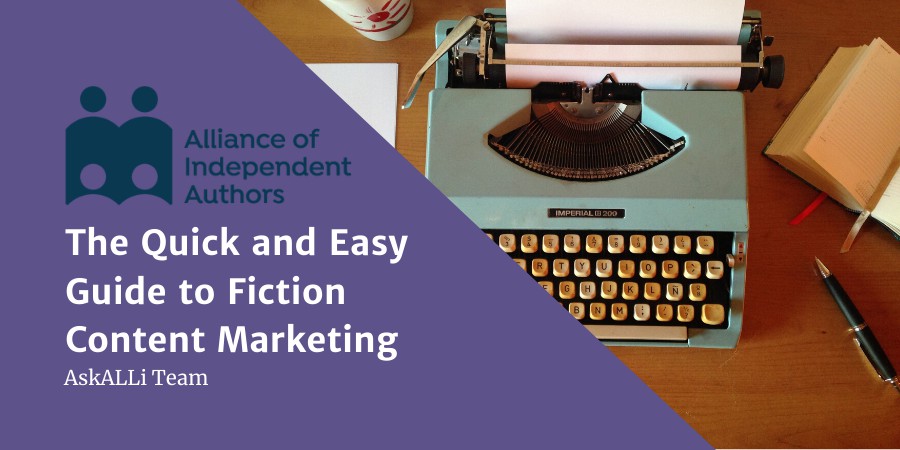Content marketing is a popular and effective form of marketing but many authors think it works best for nonfiction. Not so. This week’s #AskALLi Ultimate Guide gives you everything you need to know to supercharge your fiction content marketing.
These weekly #AskALLi guides draw on the group wisdom and experience of the advisors and members of the Alliance of Independent Authors (ALLi). Our thanks to all who shared whether through discussions in our member forums or more formally in submission and presentations. For this post, special thanks to Lucinda Brant, Australian based historical fiction author, Dan Willcocks, U.K. based dark fiction writer and Clare Lydon, UK based lesbian romance fiction author.
What is Fiction Content Marketing?
In a world saturated with paid advertising and the costs of that advertising rising, more and more authors are looking for alternative options for marketing their books. Alliance of Independent Authors Director Orna Ross, wrote an inspirational post recently where she advocated finding what's uniquely-you and then using that understanding of your personal passion and mission to build a unique, personal brand that can grow as you grow.
Your content marketing grows out of that slant of vision that's unique to you and your books. At the same time helps you to understand it.
Think of it as a lens through which you examine any content you plan to create–in text, audio or video–to ensure that it is not just appealing to your audience, but also closely connected to the ideas, voice and vision that animates your books. Each time, you ask yourself whether this particular piece of content suits your books' niche and microniche, your evolving creative intentions, and your value to your readers.
There's a widespread misbelief that content marketing is only for nonfiction. Dictionary.com identifies content marketing as:
“Marketing that tries to attract customers by distributing informational content potentially useful to the target audience, rather than by advertising products and services in the traditional way.”
That emphasis on “information” makes it sound like content marketing is only for authors of information-based books. Not so. Inspiration, entertainment, story, poetry: all can benefit from a content marketing plan.
Orna succinctly explains some of the ways novelists and short story writers can use content marketing:
“Content marketing for fiction typically includes extracts, quotes, behind-the-books information on settings or characters or plot points… or you, the author, why you were inspired to write, its themes and what they mean to you, other books (or TV, music, cinema etc) that influenced the book etc. You could link to a nice giveaway (an extract or related story that stands alone) with email sign up link. Or, if you prefer, a book buy link to capture your audience.
Consider:
-

Photo Credit: Orna Ross. Example of a graphically designed quote shared on Instagram @ornaross
Sneak peeks of chapters
- Cover reveals
- Behind the scenes look at inspirations for the book
- Free short stories or novella
- Free books (earlier book in a series, for example)
- Podcasts
- Quotes, in plain text or graphically designed for social media sharing. Make sure you include your handle and your website (like Orna has in this pic) so that if the image is shared, the new reader can easily find you and your books.
- Unboxing videos, photos or write-ups, documenting you opening a parcel of your books)
- Videos (or adding videos to already established blog posts)
- Book trailers
- Character or story related quizzes
- Character art
Actually the list is almost endless, limited only by your creativity and that all important connection to what you are trying to achieve as an artist and as a business owner.
Fiction Content Marketing: The Principles
Fiction Content Marketing Principle 1: Create content your readers will love
The best way to begin this is to choose a content theme your readers will like and that you'll enjoy creating, then regularly post content on those topics. One of those themes should be your own books but you should have at least two others.
Here are five possible content themes, “Your Book Theme” plus four other options:
- Your Book Theme: This is not lots of “buy my book” posts slapped up without thought, but carefully curated content from your books. Content includes your covers and book descriptions, as well as extracts from the book, and a purchase or pre-order link that the reader meets after they've engaged with the content.
- Book Nerd Theme: In this theme, you could post beautiful book photos, book reviews, character art, recommendations of in-genre books you've enjoyed, with ‘must-read' or ‘most anticipated' book lists for comparable authors. Also good are funny memes about reading and all things bookish, as related to your genre. You could even run author interviews, it's a great way of learning what's happening in your genre.
- Niche and Micro-niche Theme: This is a subset of general book nerdery, where you focus more narrowly on your precise niche or micro-niche within your genre e.g. the lesbian Muslim fiction niche, or the non-religious, spiritual historical fiction micro-niche. You post similar content to that listed in the book nerd theme, but related to your narrow niche and micro-niche only.
- Behind the Books Theme: Here you can share interesting information that's inspired you and your stories. For example, if you wrote dystopian YA novels you could post write ups about trips you've taken from derelict buildings—don't forget the photos. Other ideas include top ten locations to visit as a fan of dystopian YA fiction. or a list of locations you've included in your stories. Genre theme can also include radio, film and TV related to your genre, including book adaptations.
- Superfan Theme: Superfans want exclusive content, behind the scenes looks, sneak peeks, merchandise and more. Superfans want different things in different genres. Literary fiction readers like essays that explore themes or ideas. YA or fantasy readers might even dress up in cosplay of characters. Superfan historical fiction readers do historical reenactments. Have fun giving them this additional content. Get them to send you pics you can post on social media. Involve them as much as possible in your creative process too.
Fiction Content Marketing Principle 2: Post the right content to the right platform
Each social media platform has a different audience and a different culture. Instagram for example is an aesthetic platform that favors quality photos and short snippets of video stories. Twitter however, is more journalistic and newsy and often reports breaking news faster than mainstream media can. That leads to a lot of opinions on Twitter.
The principle here though is to understand where your readers hang out. Are they younger readers and using the upcoming social media platforms like TikTok? Or are they hanging out and using Facebook and posting beautiful photos to Pinterest and instagram?
Understanding the type of content each social media platform wants helps you to get the biggest bang for your content buck but experiment to find what works best. Is your gorgeous photography failing to work on Twitter and scoring on Instagram or Pinterest, or is it lost on those two image-based platforms and standing out on Twitter. Only one way to find out.
It's also important to enjoy the platform and engage with people there. Ricardo Fayet of ALLi Partner member, Reedsy.com, says:
Ricardo Fayet: you need to feel comfortable with your social medium of choice
Let's say you're a 40-year-old man writing Young Adult fiction. Does that mean that you need to create a TikTok account right now, and start doing silly videos?
Of course, you can. You might even end up loving it and build a huge TikTok following that will help sell your books — who knows!
But my guess is: you probably wouldn't feel comfortable on there, which would only lead to content creation that feels clumsy. And clumsy authors just don’t get very far with their social media marketing.
You can’t build a following on a social medium unless you're genuine, unless you understand what works on that specific platform, and interact with other users there. You need to mean what you're saying there. You need it to become part of your day that you enjoy and look forward to, not a chore.
You can't fake it, any more than you can fake emotion in a book. People feel it. And anyway, you'll get bored or frustrated. You won't last. And longevity is key.
Truth is, you can find pretty much any kind of reader on the major social media platforms today. There are 2 billion people on Facebook alone, with millions more, and many who crossover, on Twitter, Instagram, Pinterest and LinkedIn. If you put out content that's attractive to readers, and seek out other people and influencers who are interested in the stuff your books are made of, you'll build a following that will migrate across to your website and books pages.
So ensure that your social medium matches your books' genre and niche (LinkedIn is not unlikely to be great for erotic romance writers or YA fantasy writers, for example) but also ensure that it's a social medium you enjoy and want to participate in.
Fiction Content Marketing Principle 3: Stay on Brand
Once you've decided your content themes, worked out what kind of content to post and on which platform, you need to stay on brand. If you're an author of recipe books and you post recipes and food photos and then suddenly start posting about furniture, you're going to confuse your readers. Stay niche, focus on what's uniquely-you and keep generating content that gives value to those readers.
You might think there's a risk of boredom here and yes, we (and our readers) will get bored if we keep putting out the same kind of content over and over. We need to keep it creative.
As creatives, we crave the new. That's a good thing but that doesn't mean swerve off, following some new interest of our own. We must stay focussed and do the more challenging, deeper work of channelling our need for novelty into new ideas, insights and modes of expression in our own niche.
That is how a nonfiction writer becomes the expert in their field, and it's also how a novelist or poet comes to be loved for the depth and resonance of their writing. The reader may not be able to identify the quality they love but we acquire it by staying core, by carving out a space that we make wholly and uniquely our own.
Let's look at some indie authors successfully using fiction content marketing to see how it works in practice.
Fiction Content Marketing Case Study: Horror Podcasting with Dan Willcocks

Dan Willcocks, dark fiction author and The Other Stories Podcast host
Dan Willcocks dark fiction author, is the founder of The Other Stories podcast. The podcast launched in April 2015 and is dedicated to horror, science-fiction, and WTF genres. Each genre has a horror spin as their audience is slanted toward a preference for darker fiction. The podcast has now been downloaded over 5 million times.
The ALLi Team put Dan in the hot seat to answer some rapid fire questions about his content marketing strategy.
Q1. Do you write and narrate your own stories?
“No, not usually. We started with volunteer narrators. But as the podcast grew in popularity, we've been able to pay them a small fee per story. Now, 98% of the time we use other people who are professional narrators we've sourced.
I've only narrated one story in which I pretended to be a Scottish Hawk. It was an experiment we were trying for Halloween where we told a story from the point of view of a Hawk coming into someone's house and chasing the owner. Halfway through, we left a teaser code. There was a link that we hoped people would then to all go externally to our Patreon to find out more about what's going on over there.”
Q2. Do you and your podcast co-hosts write all the stories yourselves?
“That’s how it started. In the beginning we each chipped in and contributed stories for each theme we ran. With four of us writing stories, we only had to write one short story a month for production.
Over time, we opened the podcast up to submissions from other writers, and now it’s a case of whichever stories fit the theme best get taken (including our own).”
Q3. What was your intention behind starting the podcast?
“The original idea was to have my four colleagues within Hawk and Cleaver working on a collective anthology. Each author would write a 1000 word short story every month then we'd have a small emagazine we could release on KDP. The more material we released, the more chance there was of readers finding us.
One of my colleagues had podcasting experience and suggested we turn it into audio. Which is what we did. We were lucky to find narrators willing to work with us and because the work was split four ways, it made it very manageable.”
Q4. What impact has the podcast had on your fiction?
“For my reputation as a dark fiction writer, loads. It's helped with networking and getting our faces out there as people that write horror fiction. We've been nominated a couple of times for the This is Horror's ‘Fiction Podcast of the Year’ Award.
In terms of fiction paperback and Kindle sales, that's harder to say, possibly not much. One thing we're trying to focus on going forward, is drawing readers over from audio stories into reading our fiction. But we've also been in international magazines because of the podcast especially around Halloween.”
Q.5 What marketing are you doing for your books on the podcast?
“We have a call to action at the beginning and end of every podcast, but it's difficult to track if people are jumping off to purchase books. One thing we are looking at doing is bonus content. So getting new authors to either write just a small Q&A on where the story idea came from and answering a few questions interesting questions. We're then using that bonus content in the Patreon page. That'll give us an opportunity to bring in listeners and readers to a place where we can communicate with them.
We also want to focus on creating audiobooks to see how sales of those benefit from the podcast.
We're working on building the engagement with the audience at the moment. We made the mistake of just producing, producing, producing content without cultivating any expectation from the audience to do anything more. So we're now trying to work on developing that which will lead to sales or Patrons. One of the ways we're doing that is building our Facebook group which is now about 600 people strong. Because of that, we're seeing more people go off and buy the books.”
Top Fiction Content Marketing Take Away: Think Holistically
Don't think about your content marketing in isolation. When you're creating new content for your marketing, try to consider how it links to your other marketing efforts. For example, once a reader has read a blog post, where are you driving them? Do you want to push them to your Facebook group? Or perhaps a mailing list. Dan Willcocks commented that the funnel from podcast to Facebook group to Patreon to mailing list is really important to ensure you harness and capture your readers and share your future works with them.
Fiction Content Marketing Case Study: Lucinda Brant, Historical Fiction Author

Lucinda Brant
Lucinda Brant brand writes historical fiction (Georgian historical romances and mysteries) that is entertaining without compromising on historical authenticity. All Lucinda Brant books are set between the 1740s and 1780s. When readers pick up a Lucinda Brant book they are entering an 18th Century world rich in period detail, and grounded in the history.
The way I use content marketing is to focus on a specific time period. Everything I do to market my brand beyond the novels to extend my reach is concerned with promoting the 18thCentury.
Fiction Content Marketing: Using Pinterest
I use Pinterest as a visual research tool to store relevant information on my specific area of interest—the 18th Century. Boards and pins are carefully curated to ensure attribution to the original source where at all possible (be it a university, library, museum, or art gallery, etc.). As an historian and former history teacher I aim to provide students and teachers with the best and most correct information (so they can use my pins with confidence in their projects).
I also have boards about my writing life, as well as a Behind the Scenes Board for each of my novels. Behind the Scenes book boards provide readers, and anyone interested in 18th Century history, with the background, people, places, and events mentioned in that particular book. A link to the specific Pinterest board is provided in the end matter of the eBook so readers can learn more.
I am highly focused with what I pin so that over time I have become a go-to visual repository for all things 18th Century. I have over 19k followers, with a total monthly audience average exceeding 380k. And at this stage I do no advertising. It is all organic reach.
To compliment Pinterest, I’ve made guest appearances on podcasts such as Pinterest Concierge discussing Pinterest Marketing for Authors. Appeared in articles specifically about how authors can utilize Pinterest such as Kobo Writing Life, and BookBub and my Pinterest boards have featured in Hyperallergic and The Daily Beast which has a monthly readership of over 20 million.
Authors can utilize Pinterest to provide their readership with value added content. They can also showcase their expertise in a particular subject (such as I do with the 18th Century) by carefully curating their boards, so that it is not only their readership but other readers who will follow their boards and pin their content.
Fiction Content Marketing: Behind the Scenes Book Cover Videos
These Behind the Scenes videos—from concept to artwork book cover creation—not only provide readers with insight into how a book cover is created, but also allows other authors, the costume making community, digital creatives, and anyone with an interest in book cover creation, to see what we did to create the artwork for the book covers of my Roxton Family Saga. From choosing the models, to having the costumes and jewelry made, to the involvement of other creatives in the project everything goes into the video.
With each new cover release a Behind the Scenes video is uploaded to my YouTube Channel, with an accompanying blog post published on my website (pinned on Pinterest, distributed via Facebook groups, and newsletter). The post provides an in-depth analysis of the book cover from the historical research to costume creation and the final digital artwork. Here's a blog post on the creation of the Noble Satyr book cover and the Behind the Scenes video here.

Lucinda Brant's Hardback cover with behind the scenes video. Photo credit: GM Studio & Sprigleaf Pty Ltd
As well as posting these videos on my YouTube Channel, I also offer a short (less than 10sec) video clip of the cover art creation on Pinterest. The first video clip had more than 6k views in the first 24hrs of posting. You can find the short clip for Midnight Marriage (my perma freebie book) on Pinterest here.
Historically Accurate Georgian Jewelry Merchandise
I’ve partnered with Kimberly Walters, an historical costume jewelry maker who created the jewelry for my book covers, to offer the Roxton Jewelry Collection in her Etsy store.
Re-enactors, costumiers, as well as the general public with an interest in historical jewelry, so not just my readers, are able to buy these historically accurate pieces (each item comes with a Lucinda Brant tag of authenticity). As well as being available in her Etsy store Kimberly offers these pieces for sale in her pop up shop at costume fairs, re-enactor gatherings, and at select historical sites, with profits going to the upkeep of Kim’s rescue horses.
Guest Blog posts
I’ve been a guest on many blogs discussing 18th Century topics, with the articles also available through my website. A selection of my many guest blog posts on various 18th Century topics here. One such article on 18th Century wigs was picked up by renowned game board creator Vital Lacerda and the article with attribution is quoted in the rules of his award-winning board game Lisboa.
I have no way of knowing how these marketing strategies are affecting my book sales. What I do know is that I have gained readers through my Pinterest boards (emails from readers finding me through Pinterest tell me so). I am in the early stages of the Behind the Scenes Book Cover videos, with two covers done and out, and four to go! Even so, again I have received emails from readers who discovered me as an author via these videos, went on to try the free book (Midnight Marriage is a perma freebie) and then read everything else I’ve written.
Top Fiction Content Marketing Take Away: Niche Wins, Stay on Brand.
Stay on brand. Lucinda Brant has gone deep when it comes to focusing on one topic. There's a wise lesson here. When we try to please too many people and too large of an audience, we end up pleasing no one. Lucinda has gone niche, focused everything on one niche area. Everything she writes and publishes about, every video, every merchandise line, every blog post, they're all focus on the era her books are set and as a result she's built a huge following.
Fiction Content Marketing Case Study: Lesbian Romance

Lesbian Romance Author, Clare Lydon
Clare Lydon is a London-based writer of contemporary lesbian romance. She's a No.1 best-seller on lesbian fiction charts around the globe.
Q1. How do you content market?
“Number one is blogging. I've got historical blog posts that do well and a lot of them are based on stuff that readers asked me to write. So for instance, I've written a London romance series so everyone associates London lesbians with me. As a result, I get a lot of readers saying, “Hey, I'm coming to London, what should I do?” So I wrote a blog outlining the top 10 things to do in London, but I tied it in with my books. I included a lot of tourist attractions, what I like to do in London, places to eat places drink that are in my books, and cool things like, Gays the Word bookshop where my books happen to be stocked! It's a chance to say, you can buy one of my books in Gays the Word. The key is to tie it in with the book. I'll reference my characters and say do what Lucy did in London Calling and then link to that activity.
I also use podcasting. I have two podcasts: The Lesbian Book Club which has run once a month for five years. And the second one is called Lesbians Who Write, if you'd like to be notified about episodes you can here.”
Q2. What impact has the podcast had?
“Podcasting is a brilliant outlet because writing is very solitary job. Regardless of book sales, it's nice to chat with people. You also learn a lot from the other writers and it's brilliant for networking. Plus podcasts do sell books. I've got no figures so I can't promise you that the last five years of podcasting has sold X number of books. However, some of those podcasts have been downloaded thousands of times per episode. That's a couple of thousand people who've listened to me talking about my books and my book progress I also give an update on the lesbian fiction charts around the world. It's also led to co-writing with one of my co-hosts.
Interestingly, my other podcast Lesbians Who Write was aimed at writers, but the weird thing is, a lot of readers listen to it too. They want to know what we're doing and when the next book is coming. So we spend half the episode talking about what we've been doing and what we're working and then we choose a topic and talk about that for the rest of the episode. I really never expected so many readers to tune in, but it's been crazy the amount of interaction we get from people on email and comments. So I have no doubt that that podcast also sells books. And that's a happy accident.”
Top Fiction Content Marketing Take Away: be you and talk about your books
Clare continued to highlight how you can't help but be yourself on a podcast. You're talking for 30-60 minutes and you can't hide behind that. Be natural, include a section on your podcast about you and your books. Include links, photos and covers. Podcasting is much more intimate that reading a book because listeners hear your voice. You're in their head. Clare pointed out that listeners genuinely wanted to get to know you as the podcast host, which means you shouldn't be afraid to share a piece of yourself and your books.
OVER TO YOU
How do you use content marketing to promote your fiction books?
If you enjoyed this post, you might like these from the ALLi Archive:






A fascinating post. I do some content marketing on my blog, but not as much as I could do. I post some of my wip there and some poetry (which I am surprised to note gets some of the highest number of hits).
I have a promotional video on Youtube, but that yields little. Perhaps because I don’t promote it at all. I have a presence on Instagram and Pinterest that I use. Probably not enough. I was very interested to read Lucinda Brant’s experience there.
I hardly use Twitter. My main marketing is through Facebook and LinkedIn.
After reading this, I will make more effort. This was an inspiring post. Thank you. I’ll keep it for future reference.
Thank you for this article! I’ve been hesitant about the concept of content marketing for my fiction, so you gave me more confidence to keep going.
I’m making some goofy short animations that are <60 seconds long so they can play on TikTok and Instagram, then crosspost to Facebook and Twitter in a slightly different format – 4×5 for the first two, 16×9 for the latter two. They dramatize a basic theme issue that two characters from my stories come to from different POVs. For TikTok and Instagram especially, I think an important audience will be librarians since I write YA, and actual YAs are unable to buy without access to a credit card and online accounts. I'm hoping that the #librarians hashtag will help me make a connection to the librarians who are active on social media.
Facebook is more about reaching the young adults' parents, plus the 55% of YA readers who are actually adults! (per Publishers Weekly) I think the consensus is that Twitter is useful for visibility, but it doesn't drive sales. Again, hashtags seem like the way to reach specific audiences.
It's an interesting marketing challenge!
Tom
Great Tom! The librarians’ angle is an interesting approach. Let us know how you get on.
Thanks for this post, lots of things to think about. My book series is for middle-grade 9-12 which can be a difficult audience to reach on social media. However, since each book is set in a different state in the US, and I include local places in my story, I have lots of visual content to use. I find myself mostly reaching out to parents and grandparents on FB. I dapple in Instagram. But it was very interesting to hear about Lucinda’s success with Pinterest. I have inspiration boards for each book, but it has been on my to-do list to delve deeper into that. So all that being said, 2020 is the year for getting serious about content marketing, including on my website (and cleaning up my SEO there) !
good luck with it Brenda! Let us know how it goes